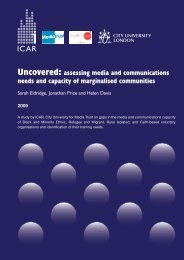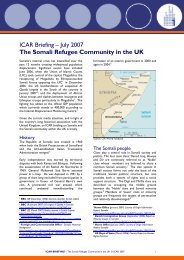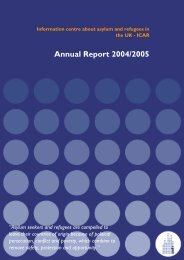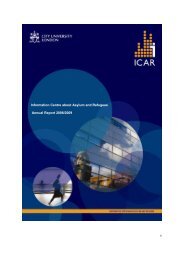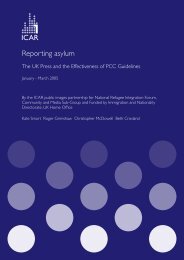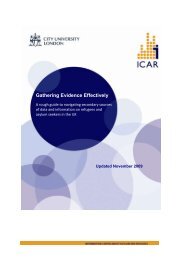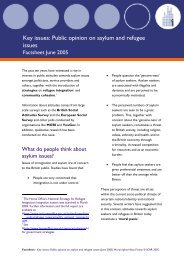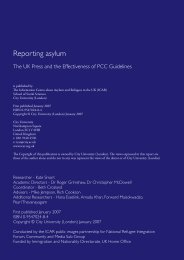The Somali community in the UK: What we know and how we ... - ICAR
The Somali community in the UK: What we know and how we ... - ICAR
The Somali community in the UK: What we know and how we ... - ICAR
You also want an ePaper? Increase the reach of your titles
YUMPU automatically turns print PDFs into web optimized ePapers that Google loves.
In <strong>the</strong> amalgamation of popular youth culture with<br />
<strong>Somali</strong> traditions of family relationships <strong>and</strong><br />
religious precept which some youngsters achieve,<br />
specific <strong>Somali</strong> associations can play an important<br />
role. <strong>The</strong> key here is <strong>the</strong> extent to which <strong>the</strong>y<br />
reflect <strong>the</strong> <strong>in</strong>terests of young people who identify<br />
with <strong>the</strong> different environments of both home<br />
<strong>and</strong> school. Ano<strong>the</strong>r contributor to <strong>the</strong> <strong>Somali</strong><br />
<strong>community</strong> meet<strong>in</strong>g po<strong>in</strong>ted out that ma<strong>in</strong>stream<br />
youth clubs, besides exhibit<strong>in</strong>g racism <strong>and</strong><br />
discrim<strong>in</strong>ation, “do not underst<strong>and</strong> <strong>the</strong> cultural<br />
needs of <strong>Somali</strong> young people”. 105 This ethnic<br />
antagonism <strong>and</strong> cultural dissonance can apply to<br />
relations with o<strong>the</strong>r black youth as <strong>we</strong>ll as white.<br />
While some young <strong>Somali</strong> men are drawn to<br />
African-Caribbean music <strong>and</strong> street style, <strong>the</strong>re<br />
also exists tension bet<strong>we</strong>en <strong>Somali</strong>s <strong>and</strong> both o<strong>the</strong>r<br />
African <strong>and</strong> African-Caribbean communities. In<br />
2002 a young <strong>Somali</strong>, Kayser Osman, was racially<br />
<strong>in</strong>sulted <strong>and</strong> knifed to death outside <strong>the</strong> Acorn<br />
youth club <strong>in</strong> Harlesden. His assailant was also<br />
black. <strong>The</strong>1996 Liverpool City Council survey on<br />
<strong>the</strong> development needs of <strong>Somali</strong> young people<br />
found that nearly all <strong>the</strong> young participants saw <strong>the</strong><br />
establishment of <strong>the</strong>ir own <strong>Somali</strong> youth centre<br />
as essential. Ra<strong>the</strong>r than promot<strong>in</strong>g a ‘heritage’<br />
culture, this was envisioned as a recreational <strong>and</strong><br />
educational centre, where young <strong>Somali</strong>s could<br />
pursue <strong>the</strong>ir <strong>in</strong>terests <strong>in</strong> a familiar social <strong>and</strong><br />
l<strong>in</strong>guistic sett<strong>in</strong>g. Young men <strong>in</strong> Leicester, hang<strong>in</strong>g<br />
out <strong>in</strong> parks <strong>and</strong> public places, wanted <strong>the</strong> same<br />
th<strong>in</strong>g. 106<br />
In Liverpool, no such meet<strong>in</strong>g place yet exists. In<br />
<strong>the</strong> Merseyside Community Centre, young men<br />
lounge about <strong>the</strong> steps <strong>and</strong> sit around <strong>in</strong> <strong>the</strong><br />
front room. <strong>The</strong>y would like a pool table upstairs,<br />
but <strong>the</strong> older generation feel this might cause a<br />
disturbance. Unemployed, undereducated, unskilled,<br />
<strong>the</strong>re is noth<strong>in</strong>g for <strong>the</strong>m to do. <strong>The</strong>y are bored,<br />
but do not feel easy <strong>in</strong> what few facilities exist<br />
for youth <strong>in</strong> <strong>the</strong> city. Unlike more recent <strong>Somali</strong><br />
settlements, shaped by younger refugees who feel<br />
more at home <strong>in</strong> ma<strong>in</strong>stream society, <strong>the</strong>se boys<br />
<strong>in</strong>herit <strong>the</strong> particularly isolated world of seafarers<br />
who have formed a <strong>community</strong> apart. But yet <strong>the</strong>y<br />
do not identify with <strong>the</strong>ir parents, with whom <strong>the</strong>y<br />
are often at odds. In <strong>the</strong> report to <strong>the</strong> April 29th<br />
2003 <strong>Somali</strong> Community Meet<strong>in</strong>g <strong>in</strong> London, <strong>the</strong><br />
youth group concluded that “<strong>Somali</strong> young people<br />
do not have a role model that <strong>the</strong>y can imitate <strong>in</strong><br />
every aspect of <strong>the</strong>ir life. This <strong>community</strong> is very<br />
new to this society <strong>and</strong> up till now <strong>the</strong>re are no<br />
successful stories that <strong>we</strong> could tell <strong>the</strong> young<br />
people”. <strong>The</strong> older seamen’s settlements are not<br />
so new, but <strong>the</strong> vicious circle of lack of education,<br />
joblessness, <strong>and</strong> poverty repeats itself through <strong>the</strong><br />
generations.<br />
<strong>The</strong> confidence of Hibo, Ubah, <strong>and</strong> countless<br />
o<strong>the</strong>r young people encourages <strong>the</strong> hope that this<br />
present lack of role models will, <strong>in</strong> time, give way<br />
to a generation of parents who have negotiated <strong>the</strong><br />
dissonance bet<strong>we</strong>en <strong>Somali</strong> <strong>and</strong> Western culture,<br />
<strong>and</strong> feel secure <strong>in</strong> <strong>the</strong>ir own identity as British<br />
<strong>Somali</strong>s. At present, despite outst<strong>and</strong><strong>in</strong>g <strong>in</strong>dividuals,<br />
<strong>the</strong> <strong>community</strong> as a whole expresses a lack of selfconfidence,<br />
betrayed <strong>in</strong> an overrid<strong>in</strong>g concern with<br />
<strong>Somali</strong> youth, ‘<strong>the</strong> future of <strong>the</strong> <strong>community</strong>’.<br />
105. Mohamoud Ahmed Nur et al: Youth report presented to <strong>the</strong> <strong>Somali</strong><br />
Community Meet<strong>in</strong>g 29.4.03.<br />
106. Daahir <strong>and</strong> Duale, 2002: 41-43.<br />
52 <strong>The</strong> <strong>Somali</strong> <strong>community</strong> <strong>in</strong> <strong>the</strong> <strong>UK</strong>





